 |
Rules and Regulations of the California Department of Corrections
Subchapter 5, Personnel To successfully meet the challenges and discharge the responsibilities of the department, the CDC requires a skilled and dedicated staff, working in close cooperation with a high degree of morale. The department encourages an equally high esprit de corps among members of the public by enabling individuals and organizations to improve their skills through training and to make their working conditions safe and pleasant. |
- The Art and Science of Billboard Improvement
- Political Art, Zeta Magazine
- Smashing the Image Factory
Political Art by Paul Von Blum
Zeta Magazine, July-August 1988, p. 103.
- History
- Billboard Correction
- The South Venice Billboard Correction Committee
- Logistics and Planning
- Sample Billboards
- Security
- Legal Issues
History
Motorists and pedestrians in Venice, California throughout the mid-1980s have been startled to see political messages in places they scarcely expected. Accustomed to thousands of commercial billboards in southern California, a natural adjunct to the region's automobile culture, they are deeply familiar with advertisements for tobacco, wine coolers, soft drinks, motor vehicles, movies, TV shows, and other expressions of the consumption-equals-good-life ideology of modern capitalism. The billboard is a central medium of popular culture, a visual form of far greater impact than any art museum or gallery.But instead of a manipulative pitch for Winston cigarettes, drivers have been confronted with a warning about American support of contra terrorism in Nicaragua. In place of the slick appeal of modern newscasters, the commuter has been asked to consider whether Kelly and Keith are delivering the news or, more insidiously, BRAINWASHING AMERICA. And rather than yet another appeal for Coca-Cola, people have been reminded of the insanity of Ronald Reagan's "Star Wars" defense system.
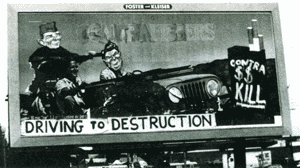 The South Venice Billboard Correction Committee (SVBCC) has taken its political commentary to the
streets - literally. Artistic guerrillas sharing a radical critique of modern society, SVBCC members
seize control of selected local billboards by transforming commercial messages into trenchant social
criticism. In the process, they join and perpetuate an ancient visual tradition that demands that
art should be relevant to human political conflicts.
The South Venice Billboard Correction Committee (SVBCC) has taken its political commentary to the
streets - literally. Artistic guerrillas sharing a radical critique of modern society, SVBCC members
seize control of selected local billboards by transforming commercial messages into trenchant social
criticism. In the process, they join and perpetuate an ancient visual tradition that demands that
art should be relevant to human political conflicts.
"Billboard correction" is a contemporary if less elegant descendant of Francisco Goya's savage assault on war, Honore Daumier's scathing attack on French monarchy, George Grosz's bitter condemnation of German militarists and industrialists, and the social critiques of hundreds of other visual artists throughout the ages. More directly, billboard correction is rooted in the impressive tradition of public art represented most spectacularly by the monumental Mexican murals of Diego Rivera, José Clemente Orozco, and Davíd Alfaro Siqueiros, from the 1920s to the early 1970s. These efforts and more recent murals in the U.S., Nicaragua, and elsewhere have encouraged billboard correction artists to communicate their critical messages to a wider public transcending the audience and content limitations of official culture.
The guerrilla art in Venice, moreover, has obvious and close connections to other modern forms of visual expression. Virtually all societies spawn graffiti. Some are overt protests against various forms of oppression and injustice; others identify youth gangs, delineate territory, and express personal sentiments about love and life. Although the form itself is typically crude, many examples combine creative imagery with socially critical comments. Billboard correction borrows heavily from this later strain of modern graffiti.
Billboard Correction
The SVBCC represents only one branch of a broader movement involving artistic-political alteration
of socially repressive commercial communications. There have been similar groups in Chile and, in
the U.S., comparable activity in New York City
and the San Francisco Area.
The most prominent expression has occurred in Sydney, Australia since 1980.
BUGA UP (Billboard Utilizing Graffitists Against Unhealthy Promotions)
is a loose confederation of artists-activists who have adapted graffiti forms to alter tobacco and alcohol billboards on
government property in Sydney. BUGA UP has "defaced" thousands of billboards in its attempt to
call widespread attention to government hypocrisy and to offer corrective measures more conducive
to public health.
The artist-activists of the South Venice Billboard Correction Committee share a similar commitment to providing information and promoting social change. They call vivid attention to the political content and implications of the modern commercial billboard. Their guerrilla alterations identify billboards as outlets for the dissemination of values promoting and reinforcing sexism, militarism, and uncritical consumption.
Because billboards are so ubiquitous, their deeper significance often goes unnoticed by a population inundated with commercial propaganda. In newspapers, on radio and television, and even in movie theaters and elsewhere, people are assaulted with solicitations to consume. Advertising transcends a mere appeal for specific products. It matters little whether audiences respond specifically to messages urging them to buy Marlboros or Winstons, Plymouths or Fords, Dan Rather or Peter Jennings. As Herbert Marcuse noted more than 20 years ago, "free" choice of a wide variety of goods and services promotes alienation if no qualitative alternatives are presented and available. Billboard "art" is the epitome of capitalist realism, a visual medium that uses women's bodies to promote consumption, that glorifies substance abuse, and that deflects public attention from glaring social and economic inequities.
Billboard correction alters these repressive tendencies by transforming them into messages of progressive and critical thought. The guerrilla approach is far more effective than merely purchasing billboard space for disseminating counter messages. Such a counter message, regardless of content, would be just another billboard, scarcely noticed and ironically destined to reinforce the perceived legitimacy of the genre itself. A deliberately altered commercial billboard, on the other hand, has a visual impact that engages viewers immediately. Vandalism gets attention. A message critical of American imperialism in Central America, for example, has a much higher chance of being noticed when it is superimposed on a tobacco ad. And this impact, finally, is the ultimate rationale for this new twist in political art.
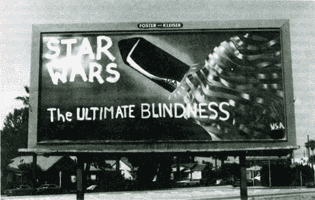
The South Venice Billboard Correction Committee
The South Venice Billboard Correction Committee is a loose confederation of people who share a
radical critique of American society and who see their surreptitious activities as a useful,
exciting expression of visual opposition. Approximately 50 academics, writers, students, artists,
and others (including many with major professional reputations in traditional society), they approach
their task with both seriousness and humor. Above all, they engage in a process of collaborative
work that fundamentally departs from the tradition of solitary artistic production.
The planning and implementation of billboard correction parallels the process of mural painting - save for one important difference. Unlike community muralists, who paint their social and political messages openly on interior and exterior walls, SVBCC activists are engaged in law breaking and strive to avoid detection by police. The clandestine character of the enterprise contributes to group solidarity and fosters the process of collective artistic endeavor.
Logistics and Planning
A glimpse at the complex logistics and planning involved in billboard correction reveals an
impressive model for communal creativity. Typically, 10 or 12 people are involved in any
particular effort. Participants gather on the evening that the alteration will occur,
often over dinner. They discuss general ideas about locale, content, and security.
Specific plans quickly follow. The initial step is to scout the billboards in a target area. Several questions must be raised and answered: How accessible are they? How high? (Excessive height imposes a variety of technical obstacles and increases time expenditures, thus increasing the possibility of police detection.) How much physical alteration is necessary? (The optimum is to use as much as possible of the billboard itself; this also saves time and decreases the chances of being caught.) Which SVBCC members should perform which tasks efficiently and expeditiously as possible? Is there time for one or perhaps two alterations during the evening?
The collective process typically continues when "scouts" return from the streets for more detailed planning. A major objective involves a sustained discussion of the political content. Should they focus on Central America? On Ronald Reagan's reactionary domestic policies? On feminist concerns? On the health hazards of cigarettes? On the political implications of dominant communications in the United States? What specific angle should be emphasized once the topic is selected?
When consensus on content is reached, discussion shifts to technique. These visual guerrillas try as much as possible to use existing pictorial and verbal elements on the billboard itself. The problem becomes what should be kept and what should be altered. Different designs are suggested and once again the group makes a collective decision. Specific tasks are assigned to the evening's participants. Some will paint, others will paste, still others will serve as lookouts.
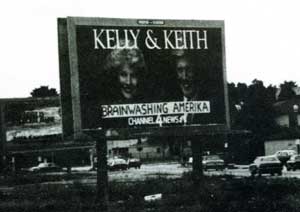
Sample Billboards
Several recent Venice examples provided insight into the alternative methods used to accomplish
the group's political-artistic goals. The easiest and fastest corrections emerge from pre-painted
paper strips on butcher paper, attached to the billboard with wheat paste. A Kelly and Keith
billboard was altered with the addition of the words BRAINWASHING AMERICA in approximately two minutes.
Other corrections involved a combination of pre-painted political message strips with a modest amount of repainting on the billboard itself. In one effort, SVBCC members swiftly changed an advertisement for Vons Supermarket into a highly visible protest against the Nicaraguan contra forces. The letter "V" was transformed into the letter "R" and the "O" was filled in with a skeletal death head, symbolizing the murderous activities of the contras and of the Reagan policy of support for them. The pre-painted strip with the words CONTRA TERRORISM: MADE IN THE USA completes the work.
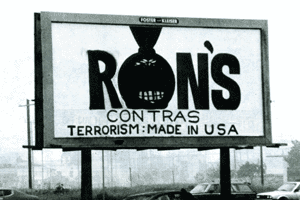 Others require more complex versions of the same technique, CONTRAFIBBERS required extensive
repainting in order to match the image of Ronald Reagan as well as paste on the pre-painted message
DRIVING TO DESTRUCTION (above). The effect is a powerful and appropriately unsubtle attack on Nicaraguan
terrorists and their chief U.S. ally in the White House.
Others require more complex versions of the same technique, CONTRAFIBBERS required extensive
repainting in order to match the image of Ronald Reagan as well as paste on the pre-painted message
DRIVING TO DESTRUCTION (above). The effect is a powerful and appropriately unsubtle attack on Nicaraguan
terrorists and their chief U.S. ally in the White House.
Some billboard corrections involve more sophisticated visual guerrilla strategies. STAR WARS (above) required changing a Coke can into a missile and the addition of accompanying captions. In addition, the slogan "Catch the Wave" had to be deleted. The billboard confronts passing drivers and pedestrians with a savage critique of Reagan's grotesque Star Wars defense plan.
The alteration of a Winston cigarettes ad involved a similar technique. There, the Winston smoker was transformed into a contra terrorist, replete with helmet, machine gun, and MADE IN THE USA insignia. The cigarette package was similarly altered to look like a missile package with a $100 million price tag for U.S. taxpayers. Finally, a small but significant change at the bottom of the billboard gives new meaning to the familiar Surgeon General's warning: Quitting Terrorism Now Greatly Reduces Serious Health Risks.
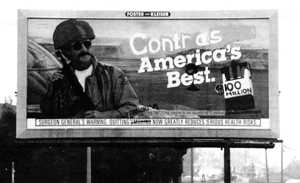
Security
Billboard correction requires considerable security planning in order to avoid detection by the
authorities and criminal prosecution. A 15-minute limit is considered the maximum allowable for
any specific project. Ten minutes or less is optimum. While four or five people are typically
on the billboard itself, a similar number watch for police or others who might interfere with the
process. Armed with flashlights, they provide instant warnings of nearby trouble. Other SVBCC team
members stand near the billboard, providing additional security. Sometimes members remain in their
vehicles, far enough away to avoid attracting attention. They warn the artists by blinking
headlights or blowing horns.
In the event of danger, billboard artists jump off if the structure is low enough. When the height is too great painters and pasters are instructed to freeze, thus minimizing suspicious movement. So far, these security procedures have been effective, for no SVBCC projects to date have been detected in process though there have been some close calls.
The final step in billboard correction is to document the results. Photographs are made and distributed to participants and sympathizers to provide durable records of radical cultural agitation and encourage similar activity elsewhere.
Legal Issues
The artistic-political activities of the South Venice Billboard Correction Committee and similar
groups raise deeper questions of law, politics, and morality. Billboard owners, commercial
advertisers, police, and probably members of the general public perceive these efforts as blatant
assaults on private property and wanton acts of illegality. Without doubt, billboard correction
is disrespectful of private property and is plainly illegal. But the issues are not so simple.
The United States has a long history of political activity that violates specific criminal laws.
There is an honorable tradition of civil disobedience that values the creation of public
consciousness higher than obedience to law.
To be sure, billboard correction is very different from the classic civil disobedience of the civil rights and anti-war movements of the 1960s and 1970s. Unlike sit-in demonstrators who actively sought arrest and willingly accepted the consequences of their violations of the law, billboard correction artists, while obviously non-violent, try to avoid detection and conduct their work under cover of darkness. Billboard correction is deliberate political dissent in visual form. It causes modest damage to dominant social and economic institutions, while conveying oppositional messages regularly ignored or suppressed in the mass media.
That rationale would scarcely be persuasive in most U.S. courtrooms. Conversations with Los Angeles area prosecutors and defense attorneys suggest that if caught, SVBCC activists would likely be charged with violating Section 594 of the California Penal Code, a malicious mischief and vandalism statue common throughout most U.S. jurisdictions.
Many conclude that it is worth the risk. In Australia, BUGA UP has altered thousands of billboards while sustaining minimal legal damage. Only a handful of the artistic activists in Sydney have been charged with and convicted of willful defacement, the equivalent of California's Section 594.
The deeper concern lies in the moral and political propriety involved in conscious law violation. SVBCC activists and their counterparts elsewhere, are far from cavalier. They perceive the harm of lawbreaking as considerably less than that of the sexism, militarism, and public passivity presently polluting the U.S. political landscape. They find that visual attack on repressive social forces and institutions is one of the few options available to political dissenters. They view their work as a modest counter to powerful governmental and corporate voices that sustain and perpetuate injustice. On balance, they find a moral and political justification for their comparatively trivial unlawful acts.
Activists elsewhere are apt to concur. Eager to combine visual technique with critical content, billboard correction activists stand to make an impact on community life through the final years of the century. In the process, they will complement their colleagues in other fields as part of a broad movement for political change. The U.S. will be the better for it.